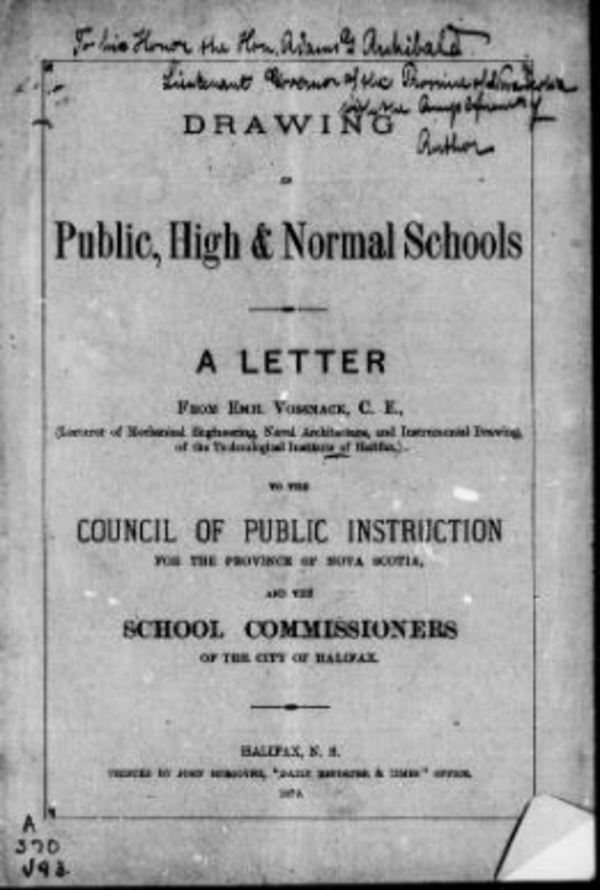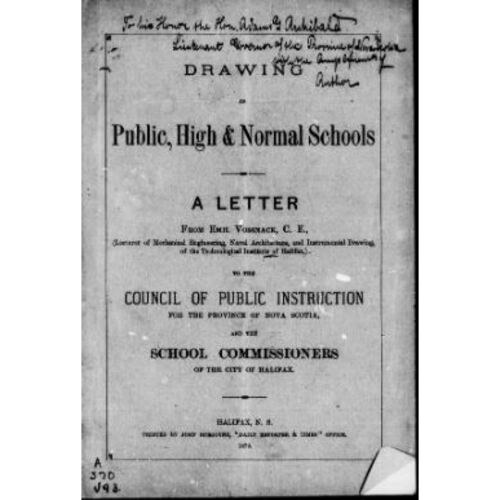
Source: Link
VOSSNACK, EMIL (Emile), engineer, teacher, and artist; b. 11 Aug. 1839 at Remscheid (Federal Republic of Germany); m. c. 1865 in New York City, Ida Cassoni, and they had four children; d. 6 Sept. 1885 at Halifax, N.S.
Emil Vossnack received professional education at the Trade School and the Polytechnic School in Karlsruhe (Federal Republic of Germany). He practised as an engineer and taught mechanical engineering for a short time in Germany before emigrating to the United States. By 1860 Vossnack was living in Chicago where he was employed at the Illinois Central Railroad shops. During his two and a half years in Chicago he closely studied the first grain elevators being built in that city and assisted in designing one of them. Vossnack also lived in Paterson, N.J., and New York City. In the latter he instructed classes in mechanical engineering at the Cooper Union and the mechanics’ institute, and was associated with Danforth and Cook’s Locomotive Shop.
In 1870 Vossnack moved to Halifax. He was employed at the Nova Scotia Iron Works where he built the first locomotives manufactured in the province. Three of these were completed in 1872, and two more in 1873, but in that same year the company went into liquidation and his contract was terminated. Subsequently Vossnack was engaged at the Starr Manufacturing Works in Dartmouth. He built both iron pipe and small rope transmissions for this company and for the mills of the Summerside and Hebb companies in Bridgewater, while at the same time superintending a large machine shop in Halifax.
In June 1876 William and Alexander Moir consulted Vossnack regarding plans to build a waterpower works, flour-mill, box mill, and grain elevator on the Nine Mile River at Bedford. They engaged him to prepare plans for the buildings, to design the machinery, and to superintend the whole works after completion. Vossnack finished this extensive enterprise entirely to their satisfaction, and was thus responsible for building the first grain elevator in the Maritime provinces.
In the 1870s there was much concern regarding the need for technical education to train men for the various industries necessary to exploit the vast natural resources of Nova Scotia. When the Technological Institute of Halifax was established for this purpose late in 1877, Vossnack was appointed lecturer in mechanical engineering, naval architecture, and instrumental drawing. Despite the lack of apparatus for effective instruction, his efforts were so successful that his students presented him with a purse and an address in token of their appreciation. In October 1878 he visited several technological schools in the United States where he collected a series of models, apparatus, and designs for use in teaching. At the request of his students Vossnack wrote a letter to the Nova Scotia Council of Public Instruction and to the Halifax school commissioners recommending the introduction of instrumental and free-hand drawing into the Nova Scotia school course as preparation for technical education. However, the Technological Institute of Halifax lasted only two years, and in March 1879 Vossnack was advertising for a position as a consulting engineer.
During the 1880s he became interested in the sulphite process of making wood-pulp for paper. In March 1883 he visited England and the Continent to study the method’s advantages. The next spring he printed a pamphlet, About sulphite wood fibre: a new substitute for rags in paper making, equal in strength, if not superior to rag pulp. In 1884 he succeeded in starting a wood-pulp company at Granville Ferry, a pioneering enterprise in the use of the sulphite process in Nova Scotia. He then became involved in promoting wood-pulp mills at Ellerhouse, in Hants County, and at Milton, in Queens County.
Vossnack had become a naturalized Canadian in January 1878. As well as being a skilled and enterprising engineer and a devoted teacher, he was a talented amateur artist. His water-colour, “Regatta, 1879,” was exhibited in 1949 at the “200 Years of Art in Halifax” exhibition. After a short but severe illness involving congestion of the brain, he died in 1885, at age 46.
Emil Vossnack was the author of About sulphite wood fibre: a new substitute for rags in paper making, equal in strength, if not superior to rag pulp (Halifax, 1884) and Drawing in public, high & normal schools: a letter . . . to the Council of Public Instruction for the province of Nova Scotia, and the school commissioners of the city of Halifax (Halifax, 1879).
PANS, MS file, Emile Vossnack, Biog.; RG 18, A, 1 (Emil Vossnack, 28 Jan. 1878). N.S., Provincial Museum and Science Library, Report (Halifax), 1931–32. Acadian Recorder, 6 June 1878, 27 March 1879, 5 March 1883, 7 Sept. 1885. Morning Chronicle (Halifax) 21, 31 Dec. 1877; 16 Oct. 1878; 7 Sept. 1885; 31 Dec. 1887.
Cite This Article
Alice Hoskins, “VOSSNACK, EMIL (Emile),” in Dictionary of Canadian Biography, vol. 11, University of Toronto/Université Laval, 2003–, accessed January 2, 2026, https://www.biographi.ca/en/bio/vossnack_emil_11E.html.
The citation above shows the format for footnotes and endnotes according to the Chicago manual of style (16th edition). Information to be used in other citation formats:
| Permalink: | https://www.biographi.ca/en/bio/vossnack_emil_11E.html |
| Author of Article: | Alice Hoskins |
| Title of Article: | VOSSNACK, EMIL (Emile) |
| Publication Name: | Dictionary of Canadian Biography, vol. 11 |
| Publisher: | University of Toronto/Université Laval |
| Year of publication: | 1982 |
| Year of revision: | 1982 |
| Access Date: | January 2, 2026 |



